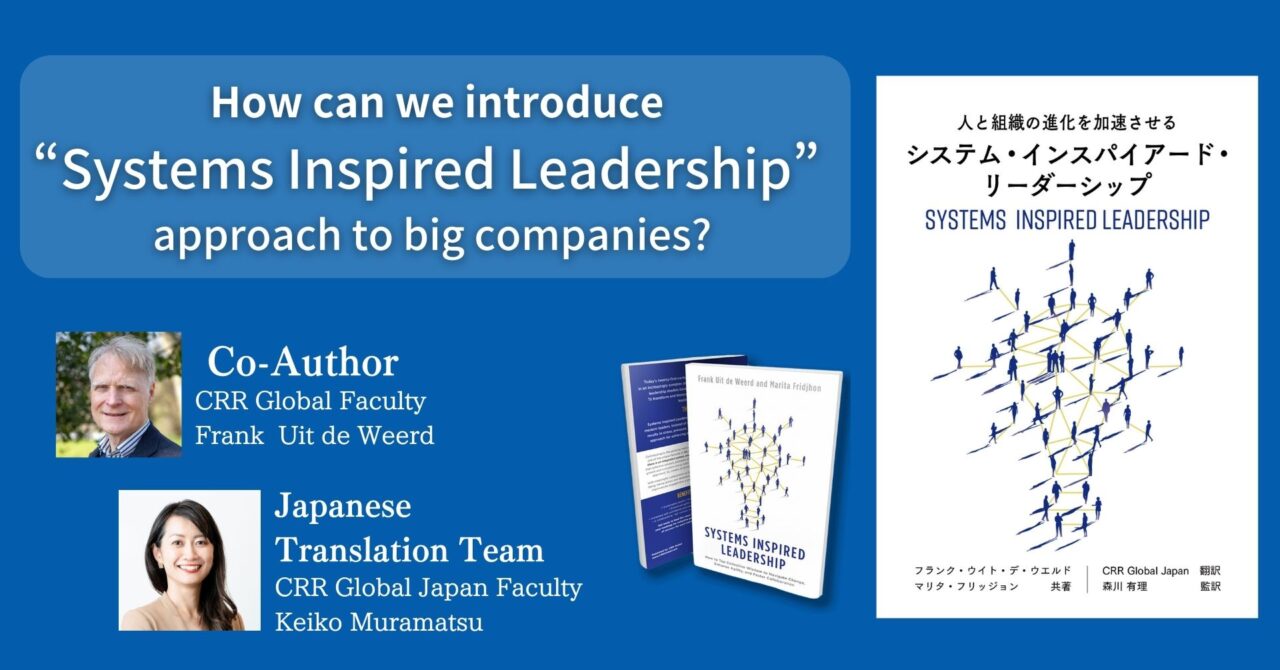How can we introduce “Systems Inspired Leadership” approach to big companies?

In January 2022, A book about a new type of leadership based on relational systems, “Systems Inspired Leadership” has been published in the United States.
The authors are the founder and the president of CRR Global, Marita Fridjhon, as well as Frank Uit de Weerd who has introduced system coaching into the organization at a global large company “Shell”.

And in a rapidly changing world, the movement to search for new ways of leadership is accelerating also in Japan, and the Japanese version of the book was finally published on May 23th in response to that.
Prior to the publication of the Japanese version, the two co-authors of this book talked about the thoughts behind it, the secret story of its birth, and the background leading up to its publication.
This article the video are the highlights of the dialogue with Frank.

Keiko: Frank, welcome. Welcome to all of you (who are participating in the event).
I am Keiko Muramatsu, a faculty member (trainer) of CRR Global Japan.

Frank: It’s great to meet you all. Thank you.
目次
Background of writing this book
Keiko: Frank, you wrote this book “Systems Inspired Leadership”, together with Marita, the founder and CEO of CRR Global, and also translated it into your own language, Dutch.
Could you tell us about this book, including its background?
Frank:
First of all, let me tell you about the background. I worked for Shell, an oil and gas company and a multinational company, for 25 years. And I knew this ORSC (system coaching) approach is so important for those organizations.
However, although it was clear how to apply ORSC approach to coaches, it wasn’t to leaders.
For example, in the courses, I heard people say, ” I’m actually a leader, not a coach, so it’s a bit more difficult to put into practice.”
Yet I have always tried to apply the ORSC approach to leadership. I was really passionate about delivering this concept to the leaders.
About this book
This book is based on the true stories of many ORSCers (CRR certified system coaches) and people who are leaders in their organizations.
Based on many interviews, it is full of wisdom to practice in the field. One of the interviewees was Keiko right here. Thank you, it was a lovely interview that I remember very well.
What we try to do in this book is to apply the ORSC approach to leaders.
What is Systems Inspired Leadership?
Keiko: What’s the definition for you of system inspired leadership?
Frank:
For me, it is the type of leadership to trust that the answer is in the system, waiting to be revealed. It contrasts with leaders who tell people what they need to do.
As a result, the leader needs to have a complete other set of competencies that help to birth these answers.
The power of relationships
Keiko: How did your 25 years of organizational experience at Shell form you to write this book?
Frank: Shell is and has been a very people-oriented company, so there was a similarity.
But still I thought that the company Shell could also learn from ORSC approach. In particular around the power of relationships.
Corporate organizations focus very much on “results”. As a result they may be destroying and violating people and relationships.
Systems Inspired Leadership can help build a web of connections. A problem solving is so much easier if the relationships are strong.

it complements the existing practices
A companies like shell with many engineers have a very analytical approach to things.
So what’s the problem? What is the course? It’s this piece.
Replace this piece and things will go better.
And Systems Inspired Leadership invites you to connect with the system and wonder what’s trying to happen, what’s wanting to emerge.
And that often means that the original problem is redefined. You start seeing things differently.
So in new solutions transformations breakthroughs will emerge.
And that’s of course very important in a world that is so complex and changing so fast.
In summary it complements the existing practices very well.
It’s not throwing these things away but it’s adding building on it.
Keiko:
I like that idea that rather than saying no to things, it’s supporting more and having a wider range.
How to introduce the idea to companies
Keiko:
As a practitioner of ORSC, I would like to know how you would bring this concept and message to the company like Shell or even more top down or business oriented companies.
Frank:
I have a couple of tips here.
First thing is to meet the system where it is.
And that’s very challenging because they may not be where you want them to be.
For example, if they are really top down or very masculine or whatever, that’s what it is.
If you’re going to say “you’re doing this wrong”, it’s not going to happen.
And then the second thing is I always start with check-in*1. Get everyone’s voice in the room and the DTA (the Designing Team Alliance*2). That creates a different atmosphere.
The third thing is that I may not always use the ORSC tools but always the ORSC competencies. Like Deep Democracy, reading and working with the emotional field, revealing the system to itself.
In the end, they say “I don’t know what you did but it’s different and something is happening”. and then you work on and you start educating more and they grow.
That’s how I work.
*1 Check-in: A tool that makes it easier for each participant to concentrate on the spot by sharing their current feelings and situations at the beginning of a meeting, etc.
*2 Designing Team Alliance: A deliberate collaborative relationship between teams. Tools that reveal what your team wants and what to do if it doesn’t work
――――
Next, we will introduce an article about an interview with Marita Fridjhon, another co-author of Systems Inspired Leadership and co-founder of CRR Global. Let’s see what kind of story will unfold.
